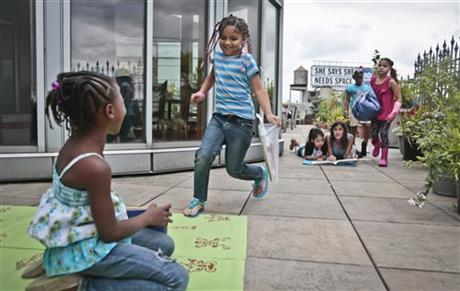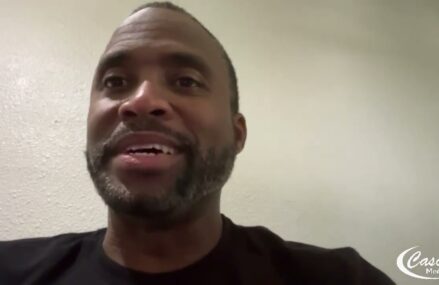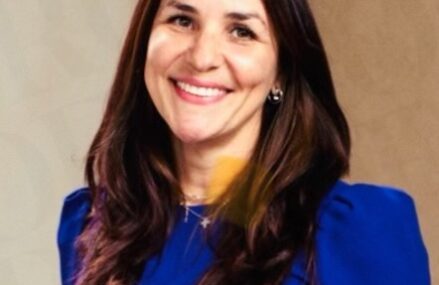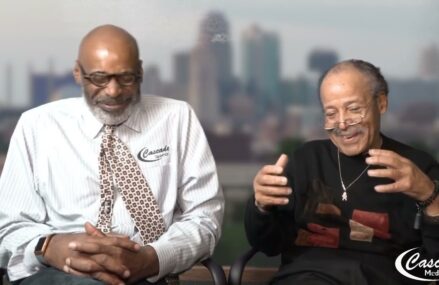
By PHILIP ELLIOTT
In this Wednesday, Aug. 7, 2013 photo, youngsters attending LitCamp, a summer reading program offered through the nonprofit literacy organization LitWorld, find sections of a rooftop patio for their independent reading, in New York’s Harlem neighborhood. “We want to do something always fun,” said Madison Graboyes, who runs the day camp. “They can read what they want. They are encouraged to feel positive about what they’re learning,” Graboyes added. (AP Photo/Bebeto Matthews)
WASHINGTON (AP) — For many students and teachers, summer vacation was more like summer term.
Reading lists. Science camps. Portfolio development. The to-do list for kids and teachers sound remarkably alike. Schools are on the hook to improve student performance on high-stakes tests, administrators are eyeing more science and technology instruction, and parents are demanding more for their children.
Some studies suggest students lose as much as two months of knowledge over the summer. Advocates say educators can’t expect their students to succeed if they, too, spend the summer months poolside.
“Summer learning space is time for innovation,” said Gary Huggins, chief executive officer of the National Summer Learning Association. “Innovation doesn’t flow easily into the school year.”
That’s why summer programs used the past few months to try new things.
Teachers in one of Chicago’s struggling elementary schools huddled for two months this summer to retool the reading curriculum for first- and second-graders.
Elsewhere, more than 4,000 teachers turned to a weeklong lesson on water purification to see if parts of it could work during the school year.
In New York City’s Harlem neighborhood, students spent six weeks flipping through books on everything from hip-hop to Depression-era toys in an effort to spark an interest in reading and narrow the gap between the scores of rich and poor students.
All were fresh approaches that could make their way into the school-year classrooms. Think of summer programs as a test drive for some lessons without the pressure, a chance to try something without consequences.
If things don’t work out, the side effect is that maybe students don’t forget so much as they learned last year.
“There’s been all this work done and investment made over the last nine months and then that investment stops,” said Pam Allyn, executive director of LitWorld, a literacy nonprofit. “For every kid — no matter where they live — out of school time is really problematic.”
Allyn compares it to sports: “If you’re going for a run or playing tennis, if you take two months off, you might have some muscle memory left but you’re not going to be in the same shape.”
That principle applies to students as well as teachers.
In Chicago, principal Shawn Jackson spent the better part of his summer meeting with colleagues to redesign the reading program at Spencer Elementary Technology Academy.
“It took us a good two months. We took the whole summer,” he said.
Their answer: a stuffed animal called “CY-BEAR.” Each student this fall will be given a stuffed bear that they will read to, reducing anxiety to perform well in front of classmates.
It sounds unusual, Jackson acknowledges, but studies have found it can help improve scores among students whose parents don’t regularly read to them. That translates to needed gains; about 85 percent of Jackson’s 930 students read below grade level and almost all come from low-income homes.
“During the school year, there are so many other variables that can come into play. Day-to-day operations, sometimes we get into their own silos, teachers have to worry about the 30 students in front of them,” Jackson said.
So he and his team competed in the Chicago Public Education Fund’s Summer Design Program, an innovation challenge that offered educators up to $10,000 to test their ideas.
“Most people would take the time to relax,” Jackson said.
Instead, he and his team rewrote the school’s reading program, overhauling how his youngest students spend two hours each day.
Discovery Communications pulled together a free series of lessons rooted in Science, Technology, Engineering and Math, or STEM, as educators brand the emphasis. One lesson on water was downloaded by 4,000 summer educators.
The lesson-in-a-box offered summer school teachers a chance to try a new way to get to students interested in STEM subjects. Video, experiments, journals — all ready for teachers and students to try to bring up their STEM literacy among fifth- to eighth-graders.
As a bonus for one of the nation’s biggest education companies, it could land them new customers during the regular school year if teachers liked what they saw.
“Teachers are teaching all day, they’re not given release time. They don’t have the time among everything else to come up with these summer lessons,” said Lance Rougeux, a former teacher who led the team that put together Discovery’s STEM camp curriculum.
Among the ready-made lessons, there’s one on water in which students build boats to transport weights, measure erosion and calculate the percentage of sugar found in various beverages, while also doing relay races with sponges and other competitions.
“I think that’s the direction people are going: to summer enrichment at a school instead of a camp where you play basketball for half the day, feed you lunch and do some crafts. There’s value in that for social development. But we can trick — I hate to say it — trick students to learn,” Rougeux said.
“If all we’re doing is baby-sitting, we don’t need summer camps. You need baby-sitting services.”
If the counselors pick up a trick or two to take with them back to the classrooms this fall, all the better.
That’s what leaders in Harlem hoped for the 40 students who attended a LitWorld Camp.
“We want to do something always fun. They can read what they want. They are encouraged to feel positive about what they’re learning,” said Madison Graboyes, who runs the day camp.
If students show an interest in cooking or animals, hip-hop or vintage toys, leaders find books that match up with their interests. Students wrote songs based on books on hip-hop and designed their own toys based on the ones they read about from the Depression, Colonial times and ancient Egypt.
“We’re not prescribed to a certain curriculum,” she said. “We’re able to take our goals for what we hope our kids can get out of it and connect that to what they want.”
That approach perhaps can offset the knowledge loss that happens when they aren’t reading and counting every day.
“None of the kids are going to sign up for a reading or math program to be honest. They’re going to sign up because they can have field trips and guest speakers,” Tiffany Cooper Gueye, CEO of summer program giant BELL that teaches thousands of at-risk students in 12 cities including Boston, San Jose, Calif., and Baltimore.
“It’s often the case we mitigate the summer learning loss,” she added. “We’re actually helping them accelerating their learning.”
___
Online:
National Summer Learning Association: http://www.summerlearning.org



